Ever watch a client strut out of your salon with a head of sleek, frizz-free hair, only to have them return with a wild mane a few weeks later? We’ve all been there. Frizz is a constant battle, and it becomes a fiercer foe for many clients as they age. But fear not! This guide is your secret weapon against this all-too-common hair woe and will equip you with the knowledge of how to fix frizzy hair and create lasting smoothness for your clients using professional hair care products.
Why Fixing Frizzy Hair Matters
Frizz is more than just an aesthetic annoyance. It can significantly impact a client’s confidence and satisfaction with their hair. Imagine that client who spent hours in your chair, finally achieving the sleek, polished look they craved. Now, picture their disappointment when that smooth style gives way to a halo of frizz. It’s a disheartening experience for your client, and it can reduce their satisfaction with your services. By conquering frizz, you’re not just creating beautiful hair. You’re boosting confidence and fostering lasting client relationships.
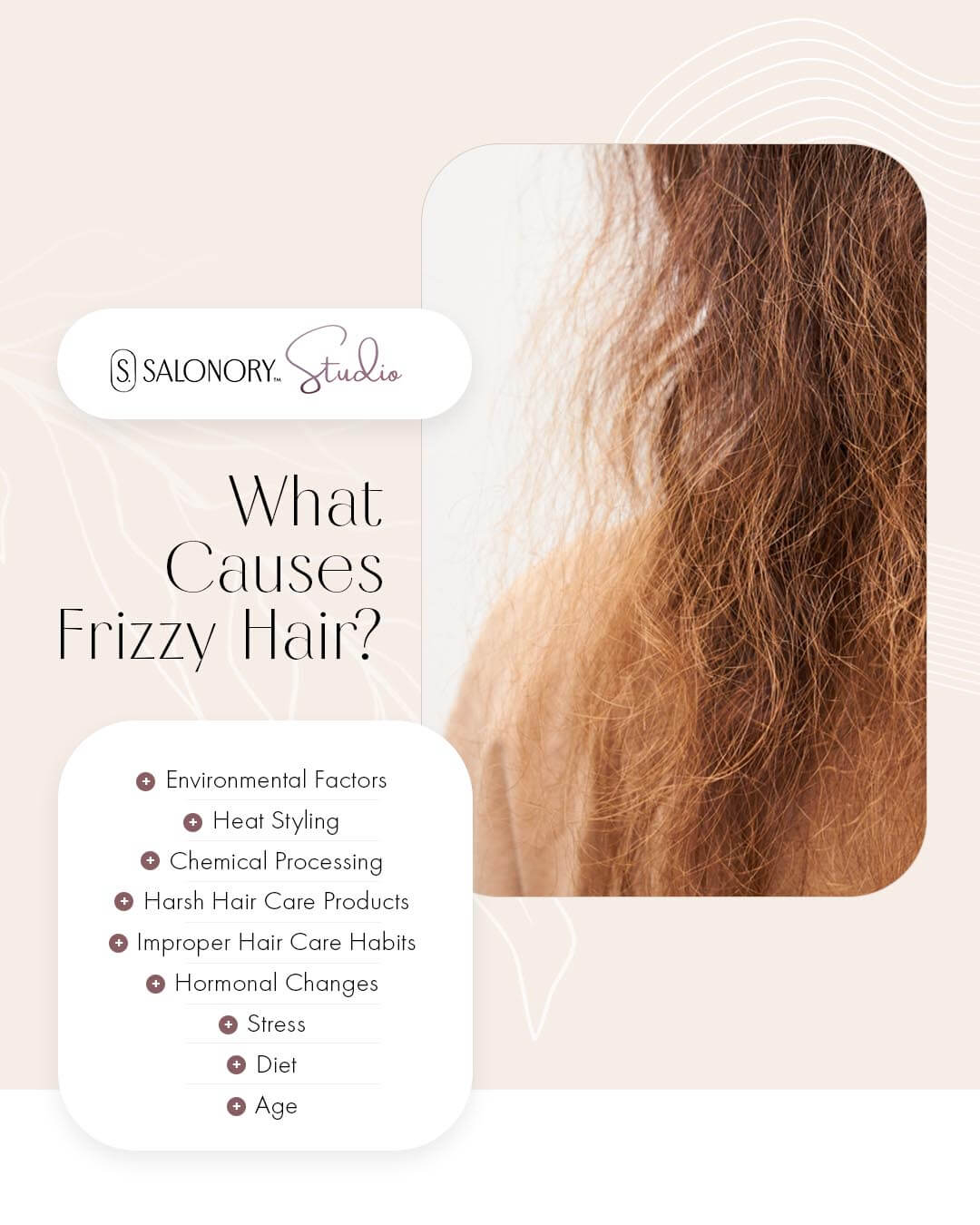
What Causes Frizzy Hair?
Frizz is a complex beast, and understanding its root causes is key to conquering it. Let’s explore the science of frizz and identify the most common factors, both internal and external, that contribute to this frustrating phenomenon.
At its core, frizz is a battle between moisture and the hair cuticle. The cuticle is the hair’s outermost layer, and when it’s healthy and smooth, it lies flat, reflecting light and creating a smooth appearance. However, when the cuticle is damaged or dehydrated, it becomes rough and raised, allowing moisture to escape unevenly. This uneven moisture escape causes the hair strands to swell and distort, resulting in the telltale frizz we all know.
Several external factors can damage the hair cuticle and contribute to frizz. Here are some key culprits:
- Environmental Factors: Humidity is a major frizz foe. As the air becomes more humid, hair strands absorb moisture, causing them to swell and frizz. Conversely, dry environments can also lead to frizz as the hair loses its natural moisture and becomes brittle.
- Heat Styling: Overuse of hot tools like blow dryers, straighteners and curling irons strip hair of moisture and damage the cuticle, leading to increased frizz.
- Chemical Processing: Lightening, coloring and perming treatments can alter the hair’s natural structure and damage the cuticle, leaving hair more prone to frizz. This is especially true among people who process their hair at home using sub-par products.
- Harsh Hair Care Products: Shampoos and conditioners with harsh sulfates or alcohols strip hair of natural oils, leaving it dry and frizzy. Salon shampoo is much gentler on hair.
- Improper Hair Care Habits: Frequent washing, rough towel drying and brushing wet hair can all damage the cuticle and cause frizz.
While the external factors above play a significant role, several internal factors can also contribute to frizz. These enemies work from the inside out, making hair more susceptible to external aggressors. Internal factors that could be causing your client’s frizz woes include:
- Hormonal Changes: Fluctuations in hormone levels that occur naturally during pregnancy, menopause and even menstruation, can affect sebum production and lead to drier, frizzier hair.
- Stress: Chronic stress can impact hair health, leading to hair loss and increased frizz.
- Diet: A diet lacking essential nutrients may weaken hair and make it more prone to frizz.
- Age: Ever had a client ask, “Why is my hair getting frizzy as I get older?” Here’s the answer: As people age, their hair undergoes physiological changes that can contribute to increased frizz. One common culprit is reduced sebum production, which leads to the hair becoming drier and more frizz-prone (as mentioned earlier). Additionally, hair follicles can become damaged over time, leading to a rougher cuticle that lets moisture escape. This makes clients’ once-smooth locks more susceptible to frizz-inducing factors like humidity.
By understanding these internal and external causes of frizz, you can better tailor your recommendations and treatments for each client.
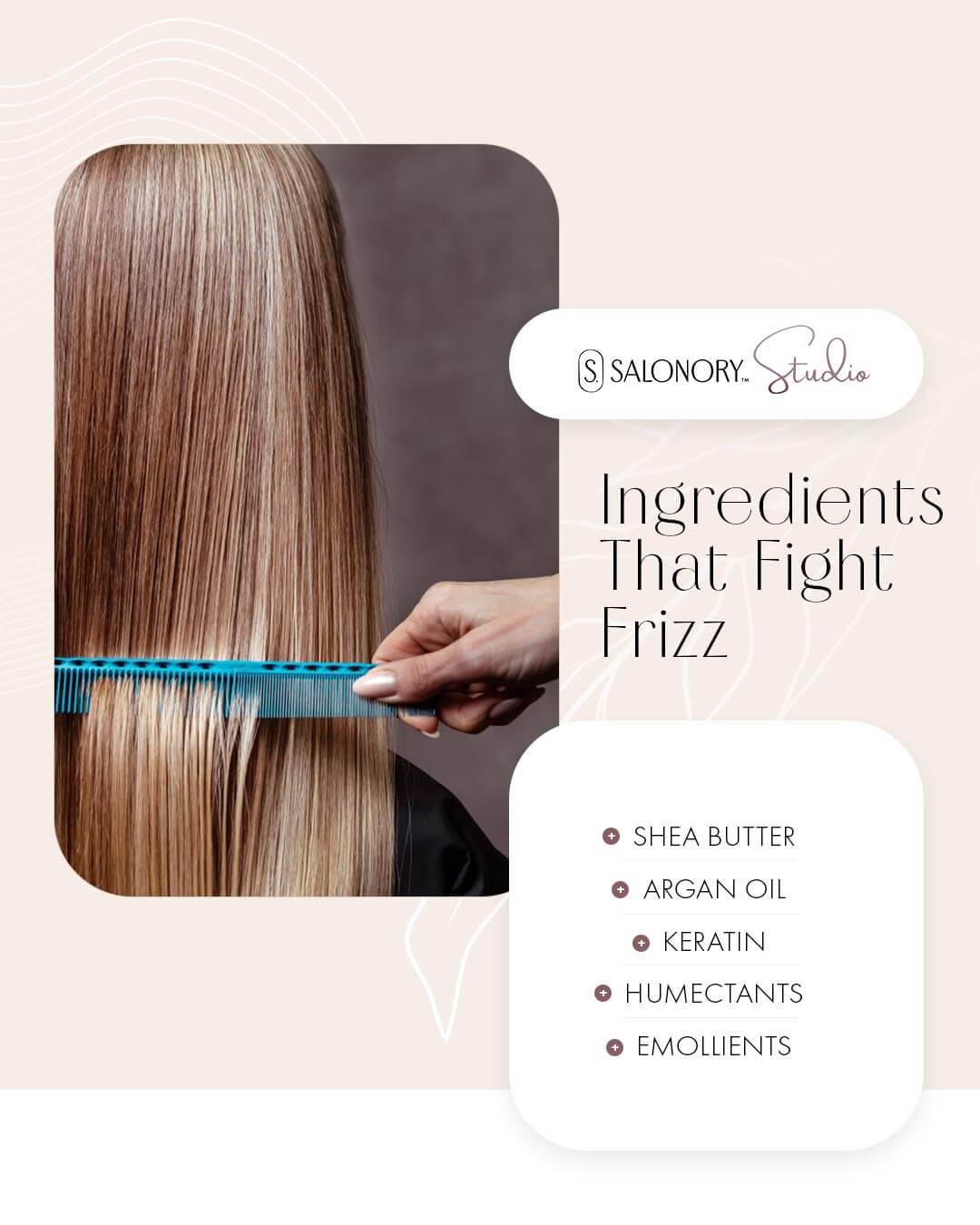
Ingredients That Fight Frizz
Hair care products containing the right ingredients are vital for fighting frizz. But knowing which ingredients are the “right” ones isn’t always easy, especially if you don’t know exactly what they all do. If you’re looking to fill your hair care arsenal with frizz-fighting powerhouses, here are the ingredients to look for (and what they do):
- Shea Butter: This creamy nut butter is rich in fatty acids and vitamins. It deeply nourishes and hydrates the hair shaft, adding shine and manageability. Shea butter also coats the hair, creating a barrier that locks in moisture and shields it from environmental frizz triggers like humidity.
- Argan Oil: Often called “liquid gold,” argan oil is packed with antioxidants, vitamin E and essential fatty acids. It works wonders on frizzy hair by taming flyaways, adding shine and improving elasticity. Argan oil is lightweight and absorbs quickly, providing deep conditioning without weighing down fine hair.
- Keratin: This protein is the hair’s main structural component. Keratin treatments work by filling in gaps in the hair cuticle, creating a smooth, polished look. The result? Hair that’s more manageable, frizz-free and resistant to humidity.
Don’t forget about humectants and emollients!
- Humectants: These moisture-loving ingredients attract water from the air and bind it to the hair shaft. Glycerin and hyaluronic acid are popular humectants. They’re particularly beneficial for dry, frizzy hair as they help replenish moisture levels and prevent the hair from becoming dehydrated and frizzy.
- Emollients: Think of emollients as hair conditioners. They work by smoothing down the hair cuticle and filling in gaps. This creates a smoother surface, reducing friction and preventing hair strands from frizzing out. Common emollients include dimethicone and fatty alcohols. They leave hair feeling soft, manageable and less prone to flyaways.
5 Ways to Fix Your Clients’ Frizzy Hair
Conquering frizz requires a multi-pronged approach, and the right arsenal of professional hair care products and techniques is essential. Here’s how to fix frizzy hair and make it smooth and manageable:
1. Start with a Clean Slate
Giving your clients smooth, manageable hair starts with using the right shampoo and conditioner. Ditch the sulfates! For frizzy hair, professional sulfate-free shampoos are essential. Sulfates can be harsh and stripping, leaving hair dry and more susceptible to frizz. Instead, use gentle, hydrating shampoos formulated for specific hair types. Pair them with rich, hydrating conditioners that penetrate the hair shaft, providing deep moisture and sealing the cuticle.
Pro Tip: Rinse your clients’ hair with cool water instead of warm. Cool water helps seal the hair cuticle, locking in moisture and reducing frizz, resulting in smoother, shinier hair.
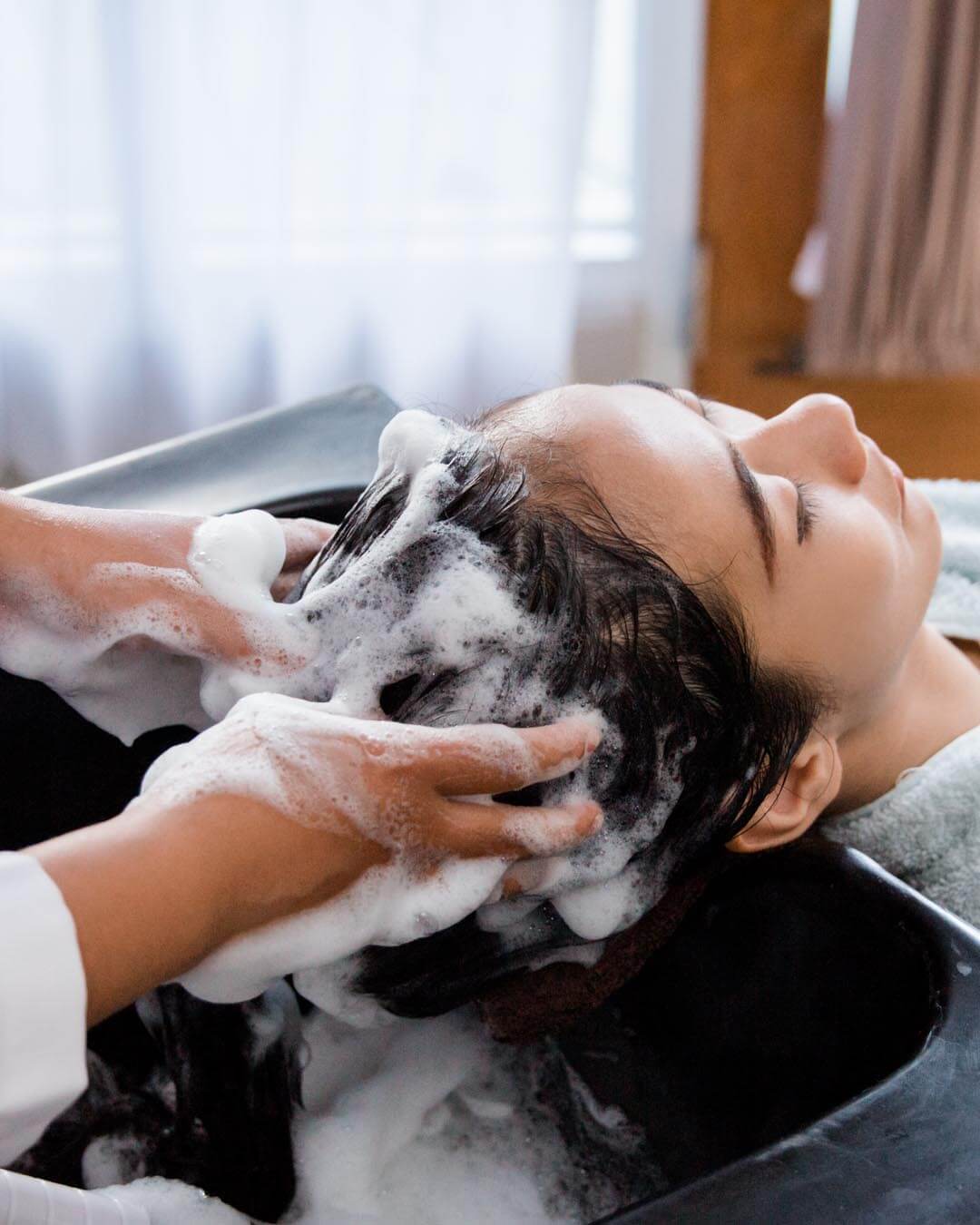
Discuss your clients’ at-home shampooing routine, too. For clients battling frizz, less can be more when it comes to shampooing. Frequent washing strips away natural oils, leaving hair dry and frizzy. Recommend reducing shampoo frequency to two to three times per week. This allows the scalp to produce enough natural oils to lubricate the hair and smooth the cuticle. For clients with oily scalps, suggest dry shampoo between washes to refresh the roots without stripping moisture from the lengths. Recommend weekly deep conditioning treatments to replenish moisture and smooth the cuticle for clients with extremely dry, frizz-prone locks.
2. Dry with Caution
Rough towel drying is a recipe for a frizz disaster! The friction from a traditional towel can damage the hair cuticle and create flyaways. Instead, go with a gentler approach. Microfiber towels are a game-changer for frizzy hair. Their super-absorbent material removes excess water without roughing up the cuticle.
Instead of aggressively rubbing your clients’ hair with a towel, gently pat or squeeze out excess water. This minimizes friction and reduces frizz.
A blow dryer with a diffuser attachment is your best friend when drying curly and wavy-haired clients’ hair. A diffuser disperses heat evenly, minimizing direct heat exposure and preventing frizz. It also helps define and enhance natural curls or waves without creating a frizzy halo.
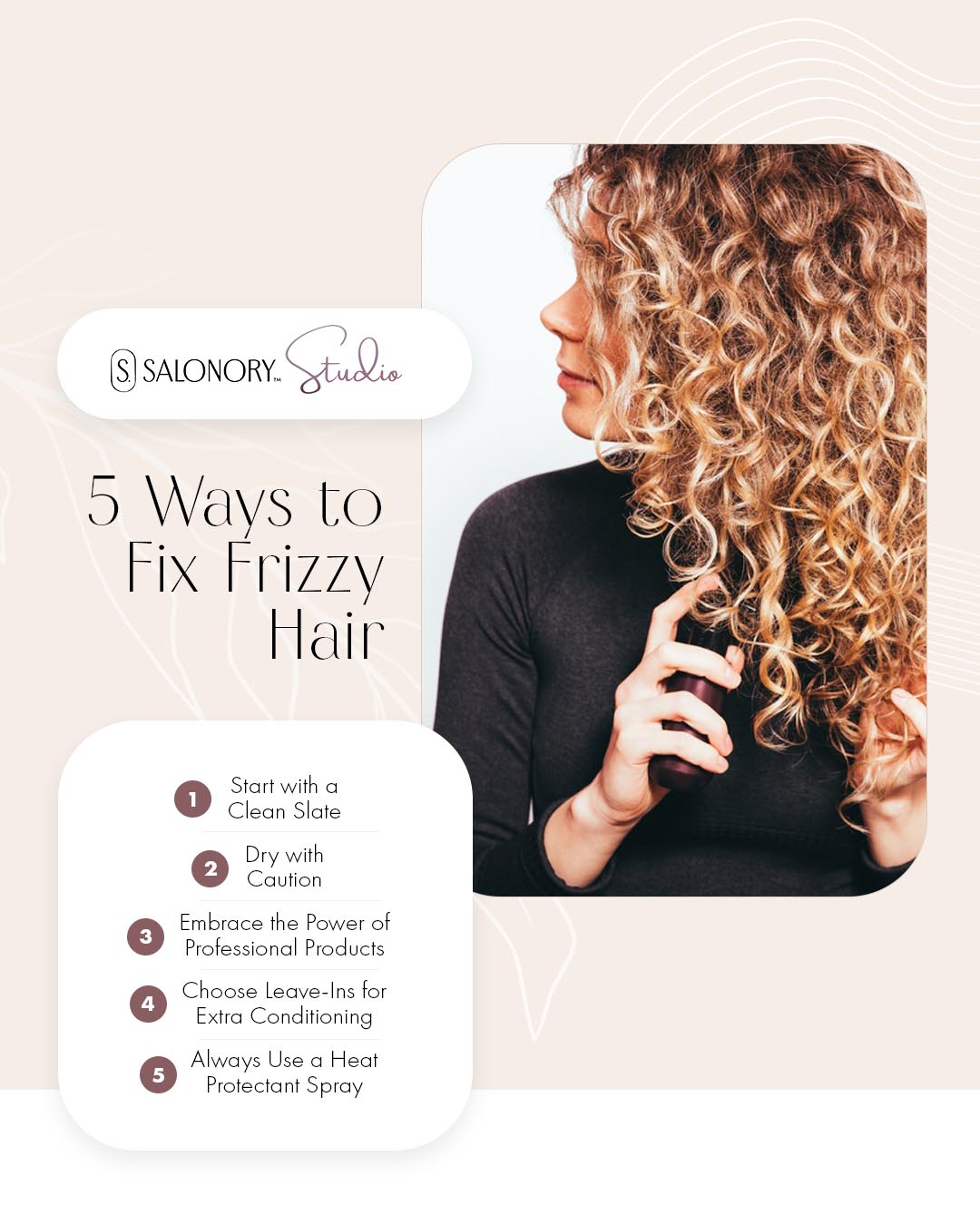
3. Embrace the Power of Professional Products
While drugstore hair care products might seem like a budget-friendly option for clients, they often lack the concentrated formulas and targeted ingredients needed to truly combat frizz. Professional salon products, on the other hand, are designed with specific hair concerns in mind. They contain higher concentrations of hydrating and smoothing ingredients, like shea butter, argan oil and keratin, which penetrate deeper into the hair shaft to provide lasting moisture and frizz control.
4. Recommend Leave-Ins for Extra Conditioning
Professional leave-in conditioners, frizz serums and styling creams are your secret weapons against frizz. These lightweight products provide continuous moisture and frizz control long after clients leave the shampoo bowl. The key is choosing the right product(s) based on each client’s hair texture. For fine hair, lightweight leave-in conditioners or frizz serums are ideal. These provide frizz control without weighing down fine strands. Richer styling creams offer more intense hydration and frizz control for coarse or thick hair.
5. Always Use a Heat Protectant Spray!
Heat styling is a double-edged sword for frizzy hair. While it can help achieve smooth styles, it can also damage the hair and exacerbate frizz. So, how can you give your clients the benefits without the damage? Use a heat protectant spray! These sprays create a barrier between hair and hot tools, minimizing heat damage and preventing frizz. Different protectants offer varying degrees of hold and shine. Discuss options with your client based on their desired style and hair type.
Tips to Prevent Frizzy Hair Post-Salon Appointment
The battle against frizz doesn’t end with the final styling touches at the salon. Here are a few ways to empower your clients to maintain their smooth, frizz-free look for longer.
Introduce your clients to silk or satin pillowcases to give “beauty sleep” a whole new meaning. These luxurious fabrics offer a smoother surface compared to traditional cotton pillowcases. Cotton’s rough texture can create friction as your client sleeps, leading to frizz, tangles and even breakage. Silk and satin, on the other hand, glide effortlessly against the hair, minimizing friction and helping to maintain the smoothness achieved during their salon visit.
A good night’s sleep shouldn’t come at the cost of a frizzy mane. In addition to using a silk or satin pillowcase, encourage clients to sleep with their hair in a loose braid or ponytail. This prevents tangles and keeps the hair from rubbing against the pillowcase, reducing frizz. For clients with curls, pineappling (loosely gathering hair on top of the head) is a great option to maintain curl definition and volume.
Traditional hair ties can create creases and contribute to frizz. Instead, recommend clients use satin or silk scrunchies. These softer materials tie hair securely without leaving marks or causing unnecessary friction.
Building a home hair care routine with the professional products you recommend is crucial for long-term success. Explain to your clients that drugstore options might be less effective than professional formulas. Professional shampoos, conditioners and styling products are designed to work synergistically, providing lasting hydration, frizz control and color protection. By consistently using the products you recommend, your clients can maintain their salon-quality smooth hair for longer.
Goodbye, Frizz — Hello, Smooth Confidence!
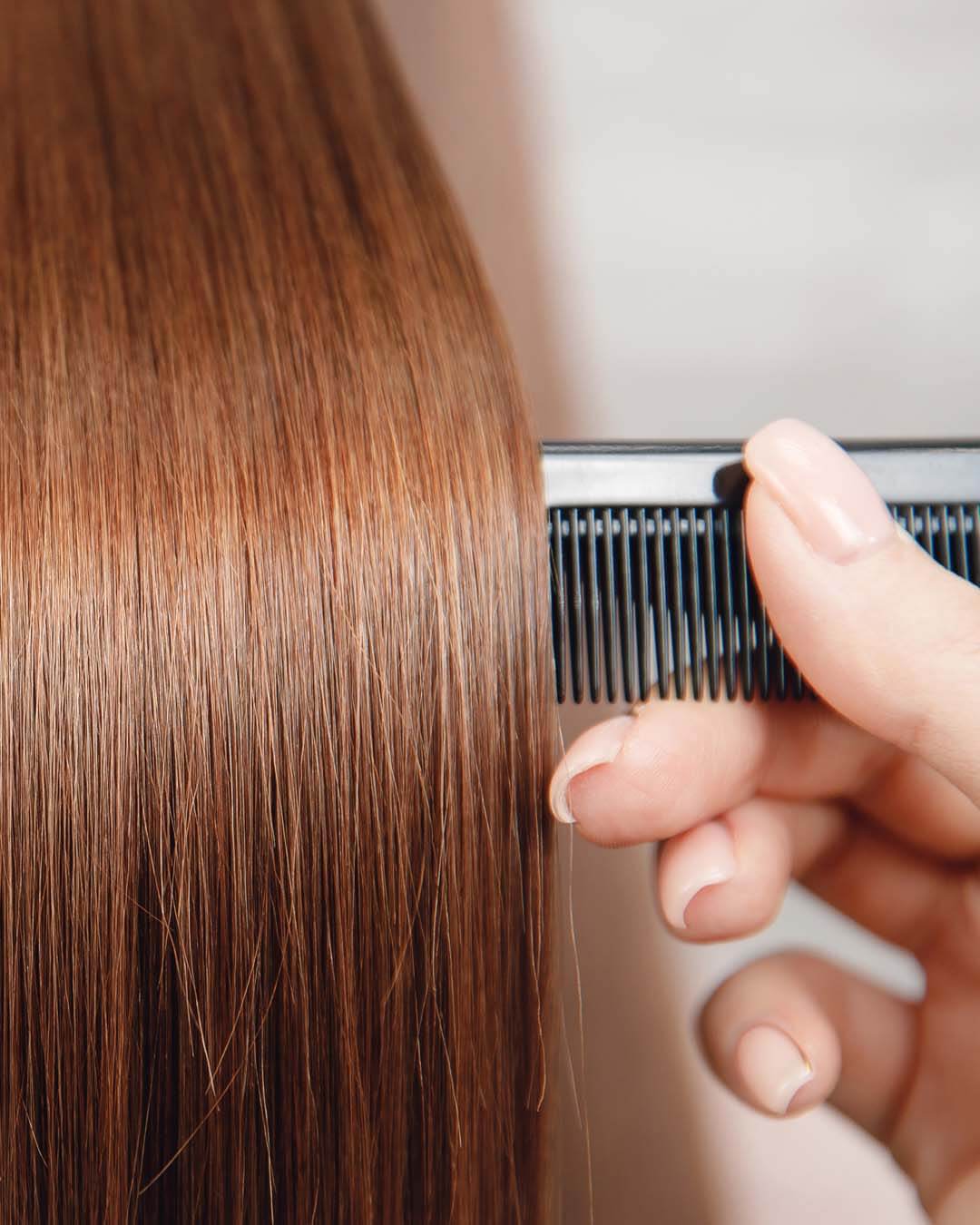
Conquering frizz is a collaborative effort between you and your client. Understanding their lifestyle, hair type and beauty goals is essential. Educate them about the “why” behind their frizzy hair and tailor a personalized approach that fits their needs. By combining your expertise with the right products and techniques, you can transform their frizzy woes into smooth, manageable confidence.
Building trust and rapport with your clients is vital. Listen to their concerns, answer their questions and involve them in decision-making. When they feel heard and understood, they’ll be more receptive to your recommendations and invested in their hair care routine.
With the right knowledge and tools, you can help your clients achieve the frizz-free locks they crave! You are not just a stylist — you are a frizz-fighting superhero, wielding the power to transform lives, one smooth strand at a time.
Image Credits
Anna Zheludkova/Shutterstock.com
iorozuya/Shutterstock.com
progressman/Shutterstock.com
Sergei Domashenko/Shutterstock.com
PeopleImages/Shutterstock.com
Odua Images/Shutterstock.com
Parilov/Shutterstock.com






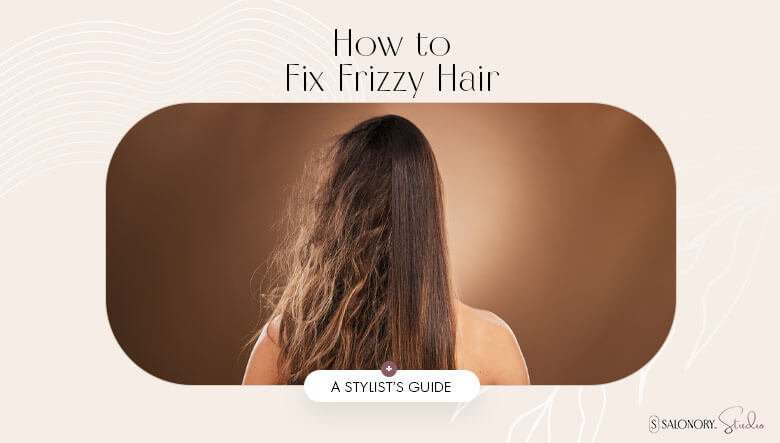


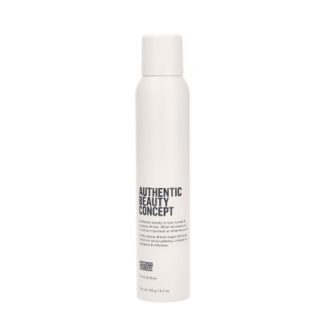
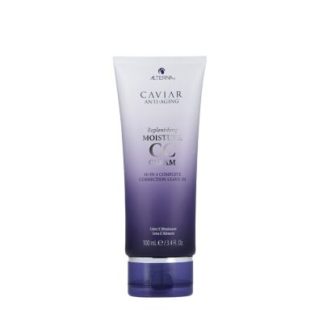
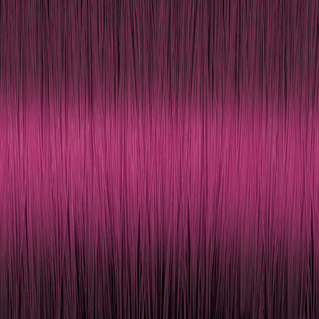
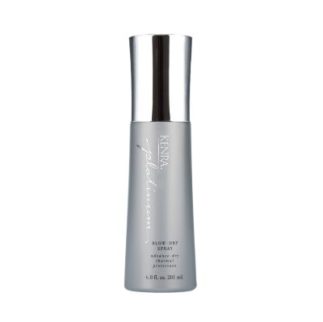
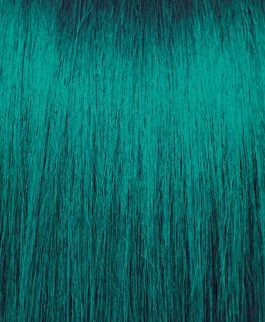
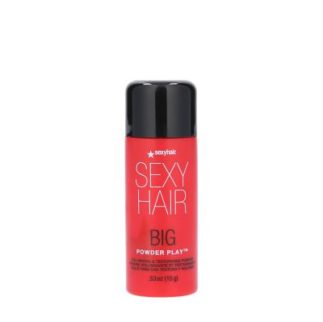
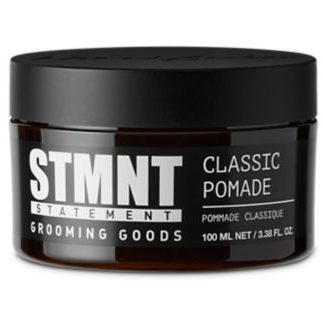
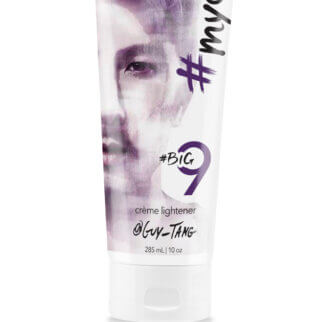
Share Your Feedback